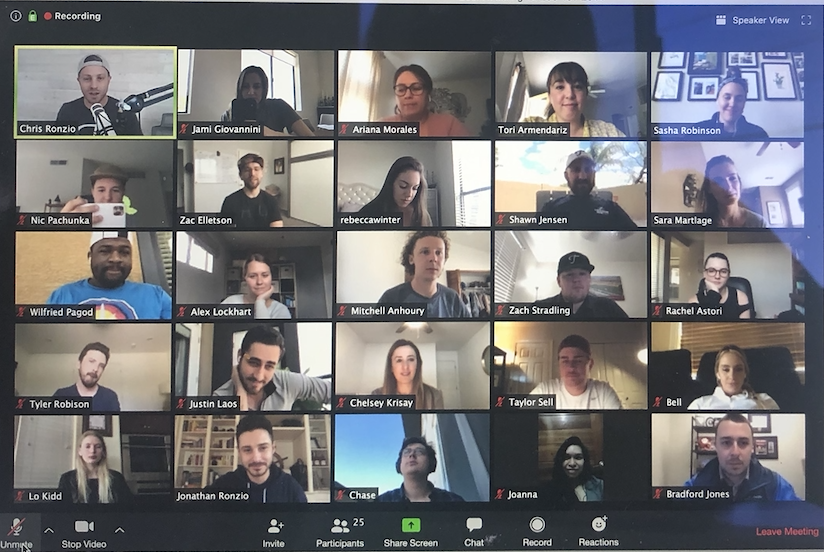
Articles
How To Roll Out COVID-19 Response Policies
March 24, 2020

I doubt anyone rang in the new decade, thinking a pandemic was going to sweep the world over. Especially not one that would reach every continent, kill thousands, cause a global economic crisis, and force teams to go remote or even downsize.
I think I speak for all of us when I say that I was not prepared for this.
But no matter how unexpected this is or how unprepared I was, as Head of People Ops, I have a responsibility to keep my team safe and supported. I am sure all of you small business owners and HR leaders feel similarly. But as we take all the protective measures we can, I worry we are not communicating our response efforts effectively, and therefore, letting our people down.
So, I wanted to break down how we are communicating Trainual's new COVID-19 response policies, and what they include, in hopes that this might make responding internally a little easier.
The Families First Coronavirus Response Act
If you’ve been following headlines from Washington, you know the federal government passed legislation to help individuals impacted by the current crisis. Most notable is the Families First Coronavirus Response Act, which goes into effect on April 1, and remains in effect through the end of 2020.
I spent most of this past weekend reviewing the policy language and notes from our legal team. I wanted to make sure I understood all the new legislation inside and out before drafting any new response policies.
Here’s what I learned about the Act:
- This act introduces significant but temporary changes to the Family and Medical Leave Act (FMLA).
- It goes into effect on April 1 and remains in effect through the end of 2020.
- It applies to all businesses with less than 500 employees.
- However, organizations with fewer than 50 employees are eligible to apply for an exemption waiver as long as you can prove the legislation imposes financial hardship for your organization (aka will put you out of business).
- For businesses interested in applying for the exemption waiver, it is not yet available.
- Emergency Paid Sick Leave requires 80 additional hours for COVID-19 related sick leave.
- Emergency Family and Medical Leave Expansion provides parents who can't telecommute and must take care of children due to school closures 12 weeks of job-protected leave (10 weeks paid).
- SMBs should implement these two sections as separate policies by April 1 and they must remain in effect through the end of 2020.
- Tax credits are available to offset this increased cost for paid leave, more info from the IRS coming soon.
How we implemented these new policies
As of today, Trainual has officially implemented the following two policies to abide by the Family First COVID-19 Response Act.
Admittedly, I have never managed sick leave, FMLA, or short term disability through a pandemic. But I can assure you that rolling out these new policies in a cold email to the team is NOT the move.
People are scared for their jobs, not being able to pay their bills, family members getting sick, or even passing away. And misinformation only adds to these anxieties, so I skipped the guessing game and went straight to our HR consultant at Justworks and our legal team before writing anything down. Then, we rolled out our new policies using these 3 steps:
Step 1: Announce verbally to the team
Yesterday, our CEO Chris presented a State of the Union, outlining our strategy for the business and our team amid the pandemic and economic crisis. He had high-level bullets from the new policies and verbally rolled them out, ending with a company-wide call for questions.

Our team-wide all-hands meeting yesterday.
Step 2: Provide access to the written policy
Right after we finished up the State of the Union, we launched the Trainual subject that we built over the weekend (and they are now available as templates here). We asked all our team members to take 15 minutes to walk through the policies at their own speed, and virtually acknowledge when they had done it.
? TIP: The easiest way to roll out your COVID-19 policies is with Trainual - try free for 7 days!
Step 3: Follow up with your team
Once the policy was sent out, I slacked the entire team, inviting anyone who wanted clarification, additional information, or just needed to talk to schedule a 15-minute call with me.
So, what should these policies look like?
Before we dive into our new policies, I want to stress that I am not an attorney, a tax professional, or even your HR lady. And this should not be taken as official advice.
I am sharing what we are doing here at Trainual in the hope that it helps you understand the implications for your team and for your business. AGAIN, I’m not an expert. I was just woefully unimpressed with the resources online and was so grateful for our legal teams help to decode the implications for a business under 50 employees.
Okay, here are our written policies:
Emergency Sick Leave Policy
To provide additional support to employees and their families, we have launched a secondary sick leave policy.
This policy offers an additional 80 hours (10 days) of paid sick leave (“emergency sick leave”) to every employee affected by COVID-19. These 80 hours are in addition to the PTO (20 days) and sick leave (5 days) already provided to every Trainual employee.
- We already offer 40 hours of sick leave and 160 hours of vacation upfront to our employees. But now we need to offer an additional emergency paid sick leave policy for COVID-19. Hear that, an additional paid sick leave policy of at least 80 hours.
- Employers may not change paid time off policies to adjust for the requirements of the Act
- This leave may not be carried over to following years
- These days are granted upfront effective April 1, 2020
- This emergency sick leave is provided for absences related to:
- Isolation due to being diagnosed with Coronavirus or being ordered to self-quarantine by a health provider due to Coronavirus concerns
- The employee is having symptoms and is obtaining a medical diagnosis of Coronavirus
- Complying with a quarantine or isolation order from a public official or health care provider
- Caring for or assisting a family member who has COVID-19, is symptomatic or has been ordered to quarantine
- Caring for a child due to the closure of school or childcare provider due to COVID-19

FMLA Protected Family and Medical Leave
*Assuming you don’t get an approved waiver*
With proper documentation, employees are eligible for up to 10 additional weeks off (14 day elimination period either paid or unpaid, and 10 weeks of FMLA leave). This even applies to employers who are not usually required to provide FMLA!
At Trainual, we will provide paid COVID-19 FMLA leave due to school or childcare closing at 66% pay based on an employee’s regular pay grade after 14 calendar days of FMLA leave has occurred.
- Pay is capped at $200/day.
- Employees will maintain all benefits.
Since our team can work remotely with ease, we happily partner with working parents that have children out of school. This might mean accomodating a (sometimes unconventional) work schedule that is more conducive to an employee’s success.
More details:
- The 12 weeks include the 80 hours of emergency sick pay. It is NOT 12 weeks of leave PLUS 80 hours of emergency sick leave.
- This leave is only required to be offered to those who are unable to work or telework because they need to care for a child under the age of 18 whose childcare or school has been closed due to coronavirus concerns.
- Employees may need to provide documentation from the school or childcare facility to prove it has closed.
- The leave must be provided to anyone who has been employed for at least 30 calendar days with your organization. Length of service, hours, location, and other requirements typically required for FMLA eligibility will not apply for COVID-19 FMLA leave.
- As with standard FMLA, insurance must be continued for employees (if enrolled) during the leave. (Employees are still responsible for their share of the premiums.)
- Since this is FMLA, the employer is required to return the employee to their position or a substantially similar position after the leave has ended. If the employer is unable to reinstate them immediately because the position doesn’t exist, they must make “reasonable efforts” to contact and reinstate the employee during the year following the end of the leave period.
We have all had to adapt quickly to the new requirements and to implement new policies seemingly overnight. Now more than ever, our top priority must be helping our teams understand the implications of these policies on their employment, their families, and their safety. Our fingers are crossed, hoping that we never have to use them. But if we do, we are doing our best to make sure we, and all our fellow business leaders, are prepared.
Similar Blog Posts











